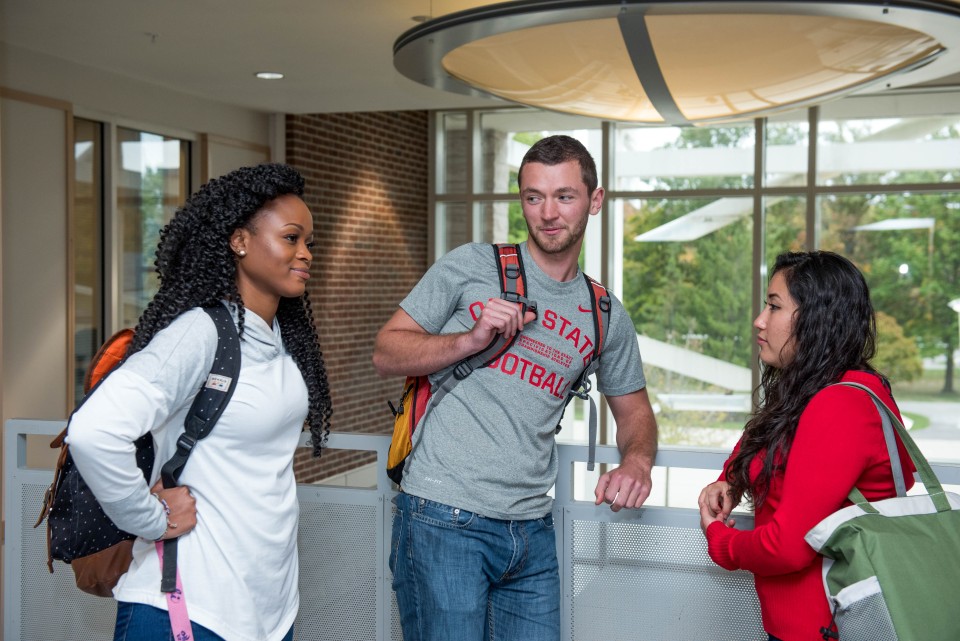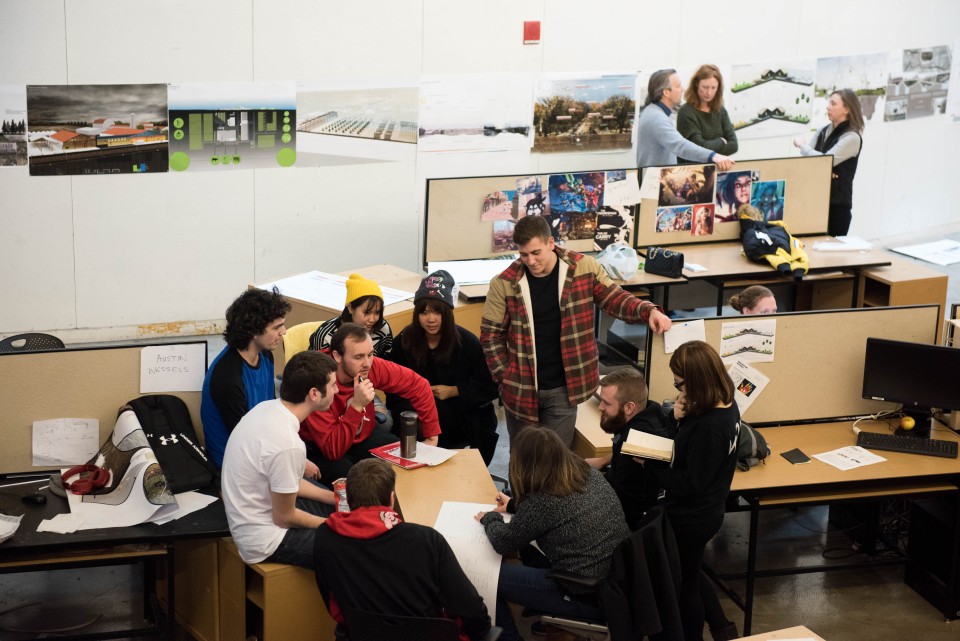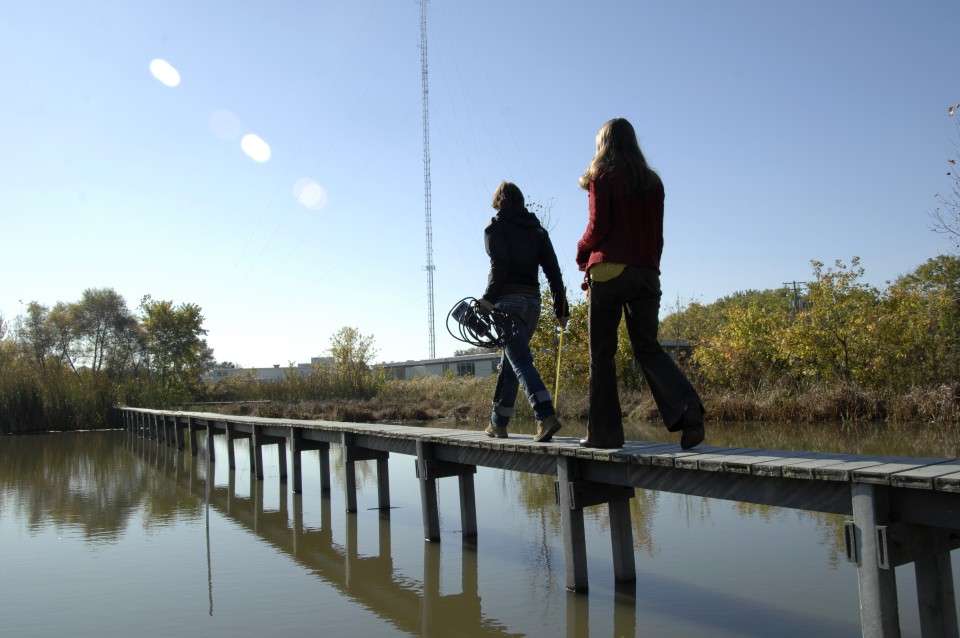
Last semester, Brutus enrolled in a service-learning course focused on improving peoples’ physical activity. Brutus built new relationships with community partners, learned about root causes of inactivity, and is now considering graduate programs in public health.
After completing an introductory engineering course in the fall, Michelle joined her instructor’s research lab. Assisting in the lab helped Michelle gain confidence in her research abilities, make connections between her coursework and research activities, and develop strong relationships with faculty mentors.
Gabe is passionate about students’ learning and the social benefits of public education, but she has struggled to articulate her career plans. By enrolling in a senior capstone course, Gabe was able to reflect on the totality of her undergraduate career and draw meaning from her most transformational experiences. She has now decided to pursue a career in educational policy.
Brutus, Michelle, and Gabe have different backgrounds, interests, and experiences. Yet because of their involvement with high-impact practices (HIPs), each has benefitted from personal, professional, and academic growth.
This resource provides a general introduction to HIPs and how to integrate these practices into your courses. We’ll explore the various course types associated with HIPs—including service-learning, research intensive, and capstone courses—and the pedagogical considerations known to facilitate students’ learning and development.
What the research says...
In 2007, the American Association of Colleges and Universities (AAC&U) introduced 10 educational practices seen as foundational to a 21st century liberal education: first-year seminars and experiences, common intellectual experiences, learning communities, writing-intensive courses, collaborative assignments and projects, undergraduate research, diversity and global learning, service- or community-based learning, internships, and capstone courses or projects (Kuh, 2008). Because of their potential to foster key student outcomes, AAC&U termed these “high-impact practices” or “HIPs.” In 2016, AAC&U added ePortfolios as the eleventh HIP (Watson et al., 2016).
Student involvement with HIPs is linked to many educational benefits, including: deep learning and personal development (Finley & McNair, 2013; Kuh, 2008), increased odds of retention (Brownell & Swaner, 2010; Dagley et al., 2016; Provencher & Kassel, 2017), and greater academic achievement (Bonet & Walters, 2016). Furthermore, the benefits of HIP participation accumulate such that when students participate in multiple HIPs, they are likely to experience more positive outcomes (Finley & McNair, 2013).
All students benefit from their involvement in HIPs. However, researchers have found that participation may be especially beneficial for students from underserved backgrounds (Brownell & Swaner, 2010; Finley & McNair, 2013; Kuh, 2008). According to findings from one national study, as students from underserved backgrounds and their traditionally advantaged peers participated in more HIPs, outcome disparities between groups were minimized (Finley & McNair, 2013).
These findings suggest that HIPs are an evidence-based approach to closing equity gaps. Unfortunately the time investment and financial resources needed to participate in some HIPs can be a barrier to participation when students have competing commitments such as caring for family, commuting to school, or working a job. Experts make the case that integrating HIPs into the core university curriculum can promote equity and inclusion, allowing all students to engage with high-impact learning as part of their daily student experience.
Pedagogical considerations
What is it about HIPs that makes them so beneficial for students? One explanation is that when thoughtfully designed and administered, HIPs boost student engagement, a key moderator for student success. For an educational experience to be truly considered “high-impact” and promote engagement, instructors are advised to attend to several pedagogical considerations (Kuh, 2008). These building blocks of HIPs contribute to students’ academic achievement, persistence, personal development, civic engagement, and sense of belonging on campus (Brownell & Swaner, 2010).
The following pedagogical principles—identified by Kuh and O'Donnell (2013) as the "eight key elements of HIPs"— are important to consider when integrating any HIP into your course.
Performance expectations
ELEMENT #1: “Performance expectations set at appropriately high levels”
First, identify expectations and course outcomes that are appropriate for students’ developmental readiness. The assignments, discussion topics, and evaluation of an introductory course will obviously differ from an intermediate or advanced seminar. Be mindful of how you can meet students where they are based on entry characteristics. Sequence your course in ways that appropriately challenge students and encourage their growth over the course of the term.
Time and effort
ELEMENT #2: “Significant investment of time and effort by students over an extended period of time”
Second, guide students to exert significant time and effort toward educationally purposeful activities. As students invest more time and energy into their curricular and co-curricular experiences, they are more likely to realize the desired outcomes of an undergraduate education (Pascarella & Terenzini, 2005). Time and effort are central to student engagement and foundational to HIP pedagogy—craft learning activities that not only require substantial time on task, but also set high expectations for students’ effort, thus encouraging quality work (Kuh, 2009).

Interaction and collaboration
ELEMENT #3: “Interactions with faculty and peers about substantive matters”
Third, facilitate shared experiences between students, their peers, and you as their instructor throughout your course. Collaborative assignments, sometimes called group projects or team assignments, have long been used in college courses. With respect to HIPs, the pedagogical benefits of fostering collaboration in your course are twofold—working with others prompts students to problem-solve while actively considering the input of peers with unique perspectives.
Experiences with diversity
ELEMENT #4: “Experiences with diversity, wherein students demonstrate intercultural competence and empathy with people and worldview frameworks that differ from their own”
Fourth, guide students to step outside their comfort zones and engage with diverse worldviews. When properly designed and administered, HIPs encourage students to actively consider new perspectives that differ from their own. Establish and maintain a learning environment where students from diverse backgrounds can feel comfortable sharing their unique experiences, actively consider new ideas, and respectfully disagree with one another.
- Review your course syllabus to ensure assigned readings, videos, podcasts, and other materials reflect authors with a range of social identities, ideologies, and lived experiences.
- Coach students early in the term on how to effectively talk about difference or across differences. You might consider the distinctions between debate, discussion, and dialogue.
- Work with students to establish community norms to which all participants (students and instructors) are accountable. Examples of community norms could include: “Speak from your own experience, not on behalf of others,” “Give your full attention to the person who is speaking,” and “Be accountable for your words, recognizing they may unintentionally cause harm to others.”
- Be mindful of the biases and assumptions you bring to the class as an instructor. Remain open to feedback and invite students to share ideas for how the course can be improved to better incorporate new perspectives.
Feedback
ELEMENT #5: “Frequent, timely and constructive feedback”
Fifth, provide students with frequent and high-quality feedback. Feedback can be understood as how you communicate your assessment of a student’s performance, relative to learning goals or learning outcomes (Education Endowment Foundation, 2022). Feedback from an instructor (or peers) is essential to bolstering students’ engagement in an experience and directing their future efforts toward educationally purposive activities. Without high-quality and consistent feedback, an educational practice cannot be considered high impact.
For example, imagine if a student submitted a reflection assignment and the only feedback you provided was, “Great job!” Although this comment is encouraging and positive, there is no indication that you closely read the assignment or took time to offer unique suggestions. As a result, the student may be less inclined to invest time and effort in future assignments. That said, feedback does not need to be overly critical, especially for informal assignments like a personal reflection.
To construct high-quality feedback, consider the following suggestions:
- Aim for a tone that is affirming and encouraging.
- Offer both positive and constructive feedback.
- When offering constructive feedback, cite specific examples in the assignment where the student can improve and fully explain your thinking.
- Connect your feedback to overarching goals of the assignment or course.
- Acknowledge instances where students’ performance improves from one assignment to the next by incorporating prior feedback.
Reflection
ELEMENT #6: “Periodic, structured opportunities to reflect and integrate learning”
Sixth, provide opportunities for students to engage in reflective practice. Create and maintain a learning environment that encourages them to synthesize what they are learning, deepen their levels of self-awareness, and reframe their perspectives. Through reflection, students can make meaning of their overall college experience. Helping them to develop the skills and habits of reflection will support their development during college and encourage an orientation to lifelong learning.
You might have students reflect through a variety of mediums, including writing journals, constructing ePortfolios, or participating in group conversations. But it is not enough to simply say, “Go reflect!” and expect positive results. The learning associated with reflection is made possible by clear instructions on how to reflect and prompts that frame the exercise. For example, soon after a learning activity concludes, ask students to recap the activity, articulate what they learned, and consider how they plan to use this knowledge moving forward. Be sure to provide students sufficient time for in-depth reflection.
Meaningful reflection is further aided when peers or instructors provide quality feedback, ask critical questions, and help students develop key ideas. Experts have argued that students are most likely to realize the full benefits associated with reflection when they receive high-quality feedback on their insights but aren’t graded for their work. This approach allows students to assign personal meaning and significance to reflection rather than seeking others’ approval.
Real-world application

ELEMENT #7: “Opportunities to discover relevance of learning through real-world applications”
Seventh, provide students opportunities to apply what they learn from involvement with a HIP in new settings and scenarios. One of the greatest strengths of HIPs is that they prompt students to apply learning to real-world situations. When incorporating HIPs into your course, consider ways to link theory with practice beyond the classroom.
There are many ways to bridge the divide between theoretical concepts and real-world applications. For instance, you might use case studies in class to bring your lecture content to life. Various projects and assignments may prompt students to propose potential solutions to local problems, articulating the pros and cons of different options for various stakeholders. Service learning is an excellent way to help students make meaningful associations between the content of their studies and issues facing community partners each day.
Pedagogy centered on real-world application not only facilitates learning, but helps students develop their identity as active citizens and community members.
Demonstration or presentation
ELEMENT #8: “Public demonstration of competence”
Finally, consider ways for students to share their learning with others. Examples include presenting to classmates, publishing an ePortfolio, or submitting an internship project for review. Beyond the feedback and evaluation they receive from their audience, the act of preparing their work for others prompts students to synthesize and articulate their learning with attention to accuracy and quality.
Courses types and experiences
The eight key elements of HIPs described above are the building blocks for integrating high-impact learning in your course, but the power of HIPs stems from how you design and administer the learning experience. This section summarizes the various course types and learning experiences where you can readily apply this pedagogical advice.
How might you integrate HIPs into your teaching? Some HIPs can be embedded as learning activities in any course, such as collaborative assignments, research projects, or ePortfolios. Other times a course is based around a specific HIP, as with service-learning and writing-intensive courses.
The transformative potential of HIPs stems from the fact that participation boosts students’ engagement in their college experience. Capstone experiences, first-year seminars, global learning, internships, learning communities, service-learning, undergraduate research, and writing intensive courses all provide ideal conditions for applying HIP pedagogy, boosting students’ engagement in their learning, and unlocking a range of educational benefits.
Read more about each high-impact course or experience below.
Capstone Experiences
Capstone experiences refer to culminating courses or projects that require students to think back on what they have learned and synthesize disparate pieces of information. Oftentimes, capstone experiences occur at the end of a student's experience, such as during their senior year or final semester before graduation (AAC&U, n.d.). Examples of capstone experiences include writing assignments, portfolios, presentations, and performances.
First-Year Seminars
The first year of college is a time of transition as students acclimate to university life. First-year seminars allow for more intimate learning environments and direct access to instructors, helping students build mentoring relationships and navigate the transition to college. The most effective first-year seminars encourage frequent writing, critical inquiry, and collaborative assignments to build students’ information literacy and engage with current scholarship (AAC&U, n.d.).
Global Learning
Global learning involves analysis of how interdependent systems (e.g., natural, physical, social, cultural, economic, political) affect peoples’ lives and the earth’s wellbeing. Education abroad is one example of global learning, but many institutions have offered new courses in recent years that allow students to engage in conversations about world issues without ever leaving campus. Through their involvement with global learning, “students should 1) become informed, open-minded, and responsible people who are attentive to diversity across the spectrum of differences, 2) seek to understand how their actions affect both local and global communities, and 3) address the world’s most pressing and enduring issues collaboratively and equitably” (AAC&U, n.d., p. 2).
Beyond fostering stronger and more authentic relationships with others, global learning prompts students to recognize challenges facing communities around the world while developing a sense of personal and social responsibility to help solve these issues (Hovland, 2009).
Learn what Ohio State students have to say about the impact of their global learning experiences in the Office of International Affairs #BuckeyesAbroad student profiles.
Internships
Internships are learning activities that “[integrate] knowledge and theory learned in the classroom with practical application and skills development in a professional setting. Internships give students the opportunity to gain valuable aligned experience and make connections in professional fields they are considering for career paths; and give employers the opportunity to guide and evaluate talent” (National Association of Colleges and Employers, 2018). All high-impact internships share certain commonalities—namely, there is a reciprocal relationship between the student and the internship site. Students contribute to the goals of their employing organization, while the employing organization contributes to students’ learning and development (in particular, students learn under the guidance of a supervisor who regularly provides constructive feedback; O’Neill, 2010).
Learning Communities
A learning community allows a small group of students (18–20) to jointly enroll in two or three classes. Some institutions provide a shared residence for students in learning communities, allowing participants to live and study together. This approach allows them to build relationships with peers and faculty members who share common interests and feel more engaged in campus life, especially at larger institutions or during periods of transition (Schmidt & Graziano, 2016).
Service-Learning
Service-learning courses leverage an experiential approach, combining meaningful community engagement, classroom instruction, and reflection. Beyond students’ volunteer activity, service-learning courses examine the root causes of issues while centering community members’ perspectives. Taking an approach that is mutually beneficial to students and partners enriches learning, promotes civic responsibility, and strengthens communities (Seifer & Connors, 2007).
Undergraduate Research
Undergraduate research can be designed as an independent study, a summer project, an embedded part of an existing course, or a paid (or unpaid) position. Although opportunities for undergraduate research are often associated with STEM fields, students from all disciplines benefit from participation in a well-crafted research project. Students involved in undergraduate research should be assigned collaborative projects that promote hands-on learning and work under the supervision of a research mentor who provides timely guidance and feedback (Bhattacharyya et al., 2018; Lopatto, 2010).
Writing-Intensive Courses
Writing-intensive courses prompt students to practice their written communication skills by repeatedly drafting (and revising) different assignments for different audiences. Examples include creative writing, quantitative reasoning, policy analysis, personal narrative, and literature review. To this end, writing-intensive courses should not be isolated to merely one course or discipline—students should expect to hone their written communication skills across the curriculum (AAC&U, n.d.).
HIPs and your Ohio State course

With Ohio State’s General Education (GE) program, students may “satisfy a particular GE Theme requirement if that course involves key practices that are recognized as integrative and high impact” (Office of Academic Affairs, 2021).
Within the context of the GE, you may think of “integrative practices” as closely mirroring “high-impact practices.” Examples of integrative courses at Ohio State that align with AAC&U’s criteria for HIPs include service-learning, education abroad and away, research and creative inquiry, interdisciplinary and team-taught courses, and courses taught in a foreign language.
Read more about General Education at Ohio State.
For guidance on how to incorporate specific HIPs into your course, check out the additional Ohio State resources provided below or contact Teresa Johnson, High-Impact Curriculum Expert in the Office of Academic Enrichment.
Summary
The AAC&U labels eleven educational practices "high-impact" because of their potential to foster key student outcomes. Eight of these HIPs are described above, including capstone experiences, first-year seminars, global learning, internships, learning communities, service-learning, undergraduate research, and writing-intensive courses.
High-impact practices (HIPs) are an evidence-based way to increase student engagement and close equity gaps. Research demonstrates that experience with HIPs benefits all students, deepening learning and personal development, increasing odds of retention, and promoting academic success. Integrating HIPs into the core university curriculum—as with the GE curriculum at Ohio State—can reduce barriers to access and allow all students to engage with high-impact learning as part of their daily student experience.
To effectively incorporate HIP pedagogy into your course, the eight key elements of HIPs (Kuh and O'Donnell, 2013) are useful guiding principles.
- "Performance expectations set at appropriately high levels"
- "Significant investment of time and effort by students over an extended period of time"
- "Interactions with faculty and peers about substantive matters"
- "Experiences with diversity, wherein students demonstrate intercultural competence and empathy with people and worldview frameworks that differ from their own"
- "Frequent, timely and constructive feedback"
- "Periodic, structured opportunities to reflect and integrate learning"
- "Opportunities to discover relevance of learning through real-world applications"
- "Public demonstration of competence"
Explore
Resources
- First-Year Seminars (Ohio State resources)
- Global Education (Ohio State resources)
- Office of Service-Learning (Ohio State resources)
- Office of Undergraduate Research and Creative Inquiry (Ohio State resources)
- Writing Across the Curriculum (Ohio State resources)
- Assessing Underserved Students’ Engagement in High-Impact Practices (AAC&U repo…
- HIPs at Ten (journal article)
- The Link Between High-Impact Practices and Student Learning: Some Longitudinal …
Learning Opportunities
References
AAC&U. (n.d.) Global learning value rubric. Association of American Colleges & Universities. https://dgmg81phhvh63.cloudfront.net/content/user-photos/Initiatives/VALUE/VALUERubric-GlobalLearningPreview.pdf
AAC&U. (n.d.). High-impact practices. Association of American Colleges & Universities. https://www.aacu.org/trending-topics/high-impact
Bhattacharyya, P., Chan, C., & Waraczynski, M. (2018). How novice researchers see themselves grow. International Journal for the Scholarship of Teaching and Learning, 12(2), 1–7. https://doi.org/10.20429/ijsotl.2018.120203
Bonet, G., & Walters, B. R. (2016). High impact practices: Student engagement and retention. The College Student, 15(2), 224–235.
Brownell, J. E., & Swaner, L. E. (2010). Five high-impact practices: Research on learning outcomes, completion, and quality. Association of American Colleges & Universities.
Dagley, M., Georgiopoulos, M., Reece, A., & Young, C. (2016). Increasing retention and graduation rates through a STEM learning community. Journal of College Student Retention: Research, Theory & Practice, 18(2), 167–182. https://doi.org/10.1177/1521025115584746
Education Endowment Foundation. (2022). Feedback: Very high impact for very low costs based on extensive evidence. Education Endowment Foundation.https://educationendowmentfoundation.org.uk/education-evidence/teaching-learning-toolkit/feedback
Finley, A., & McNair, T. (2013). Assessing underserved students’ engagement in high-impact practices [Report]. Association of American Colleges & Universities. http://files.eric.ed.gov/fulltext/ED582014.pdf
Hovland, K. (2009). Global learning: What is it? Who is responsible for it? Association of American Colleges & Universities, 11(4).
Kuh, G. D. (2008). High-impact educational practices: What they are, who has access to them, and why they matter. Association of American Colleges & Universities.
Kuh, G. D. (2009). What student affairs professionals need to know about student engagement. Journal of College Student Development, 50(6), 683–706. https://doi.org/10.1353/csd.0.0099
Kuh, G. D., O’Donnell, K., & Reed, S. (2013). Ensuring Quality and Taking High Impact Practices to Scale. Association of American Colleges & Universities. https://navigate.utah.edu/_resources/documents/quality-hips-scale-kuh-odonnell-2013.pdf
Lopatto, D. (2010). Undergraduate research as a high-impact student experience. Peer Review, 12(2). https://eloncdn.blob.core.windows.net/eu3/sites/126/2020/10/Lopatto-2010.pdf
National Association of Colleges and Employers. (2018). Position statement: U.S. internships. https://www.naceweb.org/about-us/advocacy/position-statements/position-statement-us-internships/
Office of Undergraduate Education. (2025). General Education. The Ohio State University. https://ugeducation.osu.edu/general-education
O’Neill, N. (2010). Internships as a high-impact practice: Some reflections on quality. Peer Review, 12(4).
Pascarella, E. T., & Terenzini, P. T. (2005). How college affects students: A third decade of research (Vol. 2). Jossey-Bass.
Provencher, A., & Kassel, R. (2017). High-impact practices and sophomore retention: Examining the effects of selection bias. Journal of College Student Retention: Research, Theory & Practice, 152102511769772. https://doi.org/10.1177/1521025117697728
Schmidt, L. C., & Graziano, J. (Eds.). (2016). Building synergy for high-impact educational initiatives: First-year seminars and learning communities. National Resource Center for the First-Year Experience and Students in Transition.
Seifer, S. D., & Connors, K. (2007). Faculty toolkit for service-learning in higher education. Learn and Serve America’s National Service-Learning Clearinghouse. https://docs.google.com/viewerng/viewer?url=https://community-wealth.org/sites/clone.community-wealth.org/files/downloads/tool-LSA-serv-learn.pdf
Watson, C. E., Kuh, G. D., Rhodes, T., Light, T. P., & Chen, H. L. (2016). Editorial: EPortfolios – The eleventh high impact practice. International Journal of EPortfolio, 6(2), 65–69. http://www.theijep.com/pdf/IJEP254.pdf

